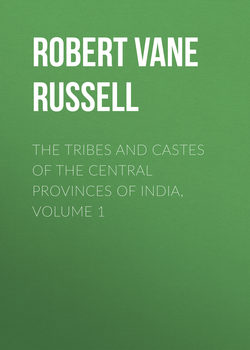Читать книгу The Tribes and Castes of the Central Provinces of India, Volume 1 - Robert Vane Russell - Страница 57
Part I.
Introductory Essay on Caste
Introductory Essay on Caste
54. Qualities associated with animals
ОглавлениеIt is probable that qualities were first conceived of by being observed in animals or natural objects. Prior to the introduction of personal names, the individuality of human beings could neither be clearly realised nor remembered after they were dead. But man must have perceived at an early period that certain animals were stronger or swifter than he was, or more cunning, and since the same quality was reproduced in every animal of the species, it could easily become permanently associated with the animal. But there were no names for qualities, nor any independent conception of them apart from the animal or animals in which they were observed. Supposing that strength and swiftness were mainly associated with the horse, as was often the case, then they would be necessarily conceived of as a part or essence of the horse and his life, not in the way we think of them, as qualities appertaining to the horse on account of the strength of his muscles and the conformation of his limbs. When names were devised for these qualities, they would be something equivalent to horsey or horse-like. The association of qualities with animals is still shown in such words as asinine, owlish, foxy, leonine, mulish, dogged, tigerish, and so on; but since the inferiority of animals to man has long been recognised, most of the animal adjectives have a derogatory sense.105 It was far otherwise with primitive man, who first recognised the existence of the qualities most necessary to him, as strength, courage, swiftness, sagacity, cunning and endurance, as being displayed by certain animals in a greater degree than he possessed them himself. Birds he admired and venerated as being able to rise and fly in the air, which he could not do; fish for swimming and remaining under water when he could not; while at the same time he had not as yet perceived that the intelligence of animals was in any way inferior to his own, and he credited many of them with the power of speech. Thus certain animals were venerated on account of the qualities associated with them, and out of them in the course of time anthropomorphic gods personifying the qualities were evolved. The Australian aborigines of the kangaroo totem, when they wish to multiply the number of kangaroos, go to a certain place where two special blocks of stone project immediately one above the other from the hillside. One is supposed to represent an ‘old man’ kangaroo and the other a female. The stones are rubbed and then painted with alternate red and white stripes, the red stripes representing the red fur of the kangaroos, and the white ones its bones. After doing this some of them open veins in their arms and allow the blood to spurt over the stones. The other men sing chants referring to the increase in the numbers of the kangaroos, and they suppose that this ceremony will actually result in producing an increased number of kangaroos and hence an additional supply of food.106 Here the inference seems to be that the stones represent the centre or focus of the life of kangaroos, and when they are quickened by the painting, and the supply of blood, they will manifest their creative activity and increase the kangaroos. If we suppose that some similar stone existed on the Acropolis and was considered by the owl clan as the centre of the life of the owls which frequented the hill, then when the art of sculpture had made some progress, and the superiority of the human form and intellect began to be apprehended, if a sculptor carved the stone into the semblance of a human being, the goddess Athena would be born.
105
See also Primitive Culture, i. pp. 119, 121, 412, 413, 514.
106
Messrs. Spencer and Gillan, Native Tribes of Central Australia (London, Macmillan), p. 201.
